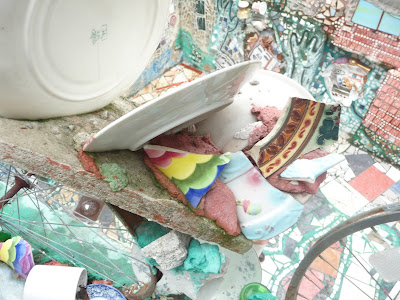
"Art should not be segregated in museums; it needs to live free among us."
-Isaiah Zagar
 We took the boys on an incredible tour of Philadelphia's Magic Gardens, which, try as I might, I couldn't capture in photos. You have to experience it...the pictures don't do justice to how extensive it is.
We took the boys on an incredible tour of Philadelphia's Magic Gardens, which, try as I might, I couldn't capture in photos. You have to experience it...the pictures don't do justice to how extensive it is. Check out this map of the murals Isaiah has all over the city.



This mural is of Isaiah's wife

As you walk through the various mosiac murals done over forty years, it's interesting to see how his work has evolved. It's cool to see all the various components...he'll push doilies into clay and paints the shapes they leave behind. Companies and people donate scraps of tile and glass for him to use.

I didn't realize we were going on such a long tour- there were alleyways, walls, and murals all around South street.
Did you know Philadelphia has more murals than any other city in the world?


Cars drive down these tiny narrow streets...
 This building used to be a fire station, he left the brick exposed as a reminder of what it used to be, and the mural is in dedication to it and the civil rights movement. Fire houses used to be segregated, and this fire house was for black fire fighters. I had no idea.
This building used to be a fire station, he left the brick exposed as a reminder of what it used to be, and the mural is in dedication to it and the civil rights movement. Fire houses used to be segregated, and this fire house was for black fire fighters. I had no idea.
 Isaiah's artist statement:
Isaiah's artist statement:I am 72 years old. I clearly remember the day I first saw Clarence Schmidt's rambling sculpture environment on a beautiful and breezy June day. I thought to myself, What is this? I had no categories, no frame of reference for it. There I stood, a third-year art student and I didn't know that I was looking at art. That was 1959.
A lot has changed in the art world, and a lot has changed in the real world. We now have a category for Clarence: vernacular artist. In 1970, after not seeing Clarence for five years, I visited Woodstock, New York where he lived and worked. His first words to me were, "I hear you are copying me in Philadelphia."
It is true to a certain extent; I have been copying Clarence my whole career, trying to make a total encyclopedic vision that has no parameters and no end. My work is marked by events and is a mirror of the mind that is building and falling apart, having a logic but close to chaos, refusing to stay still for the camera, and giving one a sense of heaven and hell simultaneously.
It is an impossible place, but strangely you can visit it and smile at that which you knew existed somewhere. Now you know that place is in Philadelphia, and you knew it all along, didn't you?
A lot has changed in the art world, and a lot has changed in the real world. We now have a category for Clarence: vernacular artist. In 1970, after not seeing Clarence for five years, I visited Woodstock, New York where he lived and worked. His first words to me were, "I hear you are copying me in Philadelphia."
It is true to a certain extent; I have been copying Clarence my whole career, trying to make a total encyclopedic vision that has no parameters and no end. My work is marked by events and is a mirror of the mind that is building and falling apart, having a logic but close to chaos, refusing to stay still for the camera, and giving one a sense of heaven and hell simultaneously.
It is an impossible place, but strangely you can visit it and smile at that which you knew existed somewhere. Now you know that place is in Philadelphia, and you knew it all along, didn't you?
1 comment:
Wow! That looks very eclectic and amazing. Philly has some amazing stuff huh? Makes me want to visit!
Post a Comment